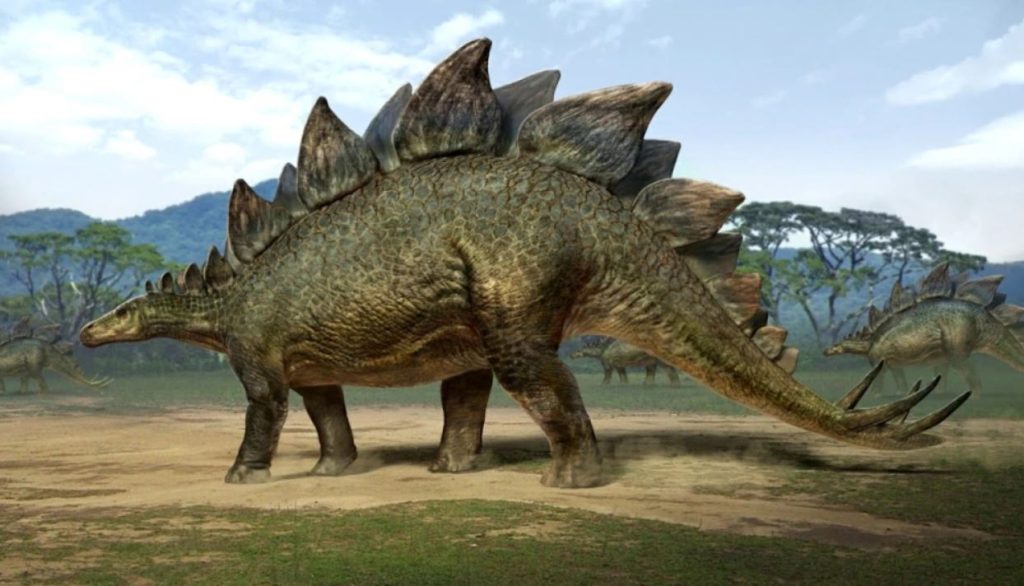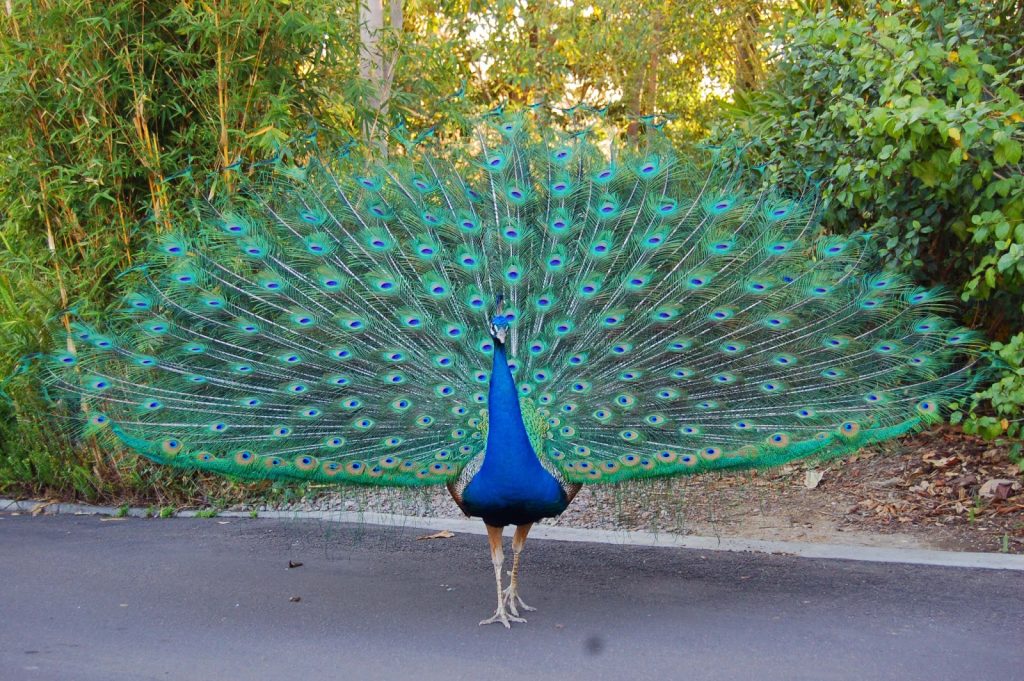Stegosaurus is an intriguing dinosaur from the Jurassic era that fascinates kids, students, and adults alike. Let’s delve into the world of this peculiar creature!
Interesting Stegosaurus Details for Learners of All Ages

A unique dinosaur indeed, the Stegosaurus was recognized for its two rows of large, bony plates running down its spine, and a collection of deadly spikes at its tail’s end.
Though not as gigantic as the Apatosaurus and Diplodocus, the Stegosaurus was still significantly larger than a human and roughly equivalent to a hefty automobile in weight.
It had a compact, flat head, and a beak resembling a turtle’s. With its four-legged walk and hoof-like toes, it presented a curious sight.
The length of its hind legs exceeded that of its front legs, giving it a somewhat unusual, ‘head-down’ posture. This characteristic would have limited its speed. Its maximum velocity is estimated to be about 6 to 7 km/h (3.5 to 4.5 mph).
Its longer hind legs may have allowed the Stegosaurus to rear up, using its tail as support.
Being a plant-eater or herbivore, the Stegosaurus posed no danger to humans unless it perceived them as threats, in which case it would swing its spike-laden tail menacingly.
Want to learn more about the Jurassic period?
Here’s an article: Dinosaur Periods.
What’s in a Name: Stegosaurus
The Stegosaurus was discovered in the 19th century. Initially, it was believed that its plates lay flat on its back, much like a roof’s tiles, leading to its name ‘Stegosaurus’, originating from the Greek term for “roofed lizard”.
Is There More Than One Kind?
Stegosaurus was part of the Thyreophora, or ‘armored dinosaur’ group of dinosaurs, which also included the Ankylosaurs.

The term ‘Stegosaurus’ refers to a ‘genus’, which is a ‘type’ of animal, rather than a single species. A genus could contain one or multiple closely related species.
There has been considerable debate among scientists over the years about whether there were several distinct Stegosaurus species, or just a single species with variations in size and appearance.
Currently, the three main recognized Stegosaurus species are:
- Stegosaurus ungulatus, “hoofed roof lizard”
- Stegosaurus stenops, “narrow-faced roof lizard”
- Stegosaurus sulcatus, “furrowed roof lizard”
These were all identified by the American paleontologist Othniel Charles Marsh in the late nineteenth century. As more information about the Stegosaurus becomes available, more species may be added, or some may be grouped into a single species.
When Did the Stegosaurus Exist?
Stegosaurus roamed the earth around 150.8 to 155.7 million years ago, during the Jurassic period, coexisting with dinosaurs like the Apatosaurus, Diplodocus, and Brachiosaurus.
Predators of the Stegosaurus?
Despite its large size and armored body, the Stegosaurus would have fallen prey to predators such as the Allosaurus and Ceratosaurus.
The Size of the Stegosaurus
Even though the Stegosaurus didn’t hold the title for the largest dinosaur, it would have appeared colossal when compared to most land animals of today. The largest Stegosaurus could grow up to approximately 30 feet (9 meters) long and stand about 2.75 m (9 feet) tall.
Weighing around 5,000 kg (5 metric tons / 5.5 short tons), it shared a similar weight range with today’s largest land animals, the African Elephants.
Stegosaurus’s Iconic Plates

The Stegosaurus was characterized by two rows of bony plates extending from just behind its head to almost the end of its tail.
These plates were formed from a tough, bone-like substance, not connected to the skeleton, but instead grew out from the skin. They are examples of ‘osteoderms’, bony structures like armored scales and plates present in the skin of many of today’s animals, including crocodiles.
The interior structure of the Stegosaurus’s plates were filled with blood vessels and had a lattice-like appearance.
The purpose of these plates is a topic of many theories. Were they purely for defense, or did they serve other functions? One theory proposes that they helped the Stegosaurus regulate its body temperature. The dinosaur might have oriented its plates towards or away from the sun, effectively warming up or cooling down.
A more recent hypothesis suggests that the plates were primarily for display. The larger or more vividly colored the plates, the more appealing the dinosaur would have been to potential partners.
A modern-day analogy would be a peacock’s tail. Although it doesn’t have a practical function, its color and condition reflect the bird’s vitality and health, making it more appealing to females.

The Spiked Tail of the Stegosaurus
At the end of its tail, the Stegosaurus had a group of fearsome spikes. Fossil evidence shows signs of wear and damage at the ends of these spikes, indicating that they might have been used as defensive weapons against predators.
Indeed, numerous Allosaur fossils bear injuries that could have been inflicted by such spikes. (The Allosaurus was a large, carnivorous dinosaur that hunted Stegosaurus.)
A Small Brain in a Big Body
The Stegosaurus was not believed to be particularly intelligent, largely due to its small, narrow head, which had limited space for a brain.
A commonly shared fact about the Stegosaurus is that its brain was the size of a walnut. However, recent research suggests that it was more comparable to the size and shape of a hotdog. Regardless, for a creature of the Stegosaurus’s size, this is still considerably small!
The Diet of the Stegosaurus
As a herbivore, the Stegosaurus fed on plants. Many plant-eating animals have strong jaw muscles and large teeth to break down the fibrous plant material for easier digestion.
However, the Stegosaurus had a weak beak, lacked front teeth, and had small, peg-like teeth on the sides of its mouth. Its jaw was fairly rigid, limiting its motion. It likely stored food in its large cheeks, allowing ample time to chew its food before swallowing.
The long hind legs of the Stegosaurus suggest that its head would have been held close to the ground, leading scientists to believe that it fed on low-lying plants (not grass, which only emerged in the Cretaceous period!).
However, if it could indeed stand up on its hind legs, it would have been able to feed on vegetation from taller shrubs or trees.
Behavior of the Stegosaurus
Determining dinosaur behavior is an arduous task given the ancient nature of fossil evidence. However, scientists have managed to paint a picture of how the Stegosaurus may have behaved using these paleontological clues.
Several instances of Stegosaurus tracks found in the same vicinity suggest the dinosaur was likely social and might have moved in herds. Further reinforcing this idea, a collection of Stegosaurus specimens – both adults and juveniles – was discovered, implying that they lived within family units.
Where are Stegosaurus Fossils Found?
A substantial number of Stegosaurus fossils, about 80, have been unearthed in the Morrison Formation – a prominent fossil site located in Wyoming and Colorado.
Fossils of the Stegosaurus have also been discovered at other sites in Wyoming and as far away as Portugal. This geographical spread provides evidence that the continents of North America and Europe were once interconnected during the Jurassic period.
The Myth of the Second Brain
Scientists once postulated that the Stegosaurus possessed a second “brain” situated near its hind legs due to the small size of its actual brain. However, this theory has since been discarded!
Top Ten Fascinating Stegosaurus Facts for Kids, Students, and Adults
- The name “Stegosaurus” translates to “roofed lizard.”
- The Stegosaurus thrived during the Jurassic period, approximately 150.8 to 155.7 million years ago.
- An adult Stegosaurus could reach up to 30 ft. (9 meters) in length.
- It weighed roughly the same as an African Elephant – the heaviest land animal living today.
- The Stegosaurus featured two rows of bony plates along its back, which may have served either for thermoregulation or display.
- The Stegosaurus could ward off predators such as Allosaurs using the spikes on its tail.
- Despite having a brain the size of a hotdog, the Stegosaurus was not considered particularly intelligent.
- The Stegosaurus was a herbivore, consuming low-lying shrubs and bushes.
- Fossil evidence indicates that the Stegosaurus may have lived in herds.
- Fossils of Stegosaurus have been discovered in both North America and Europe.